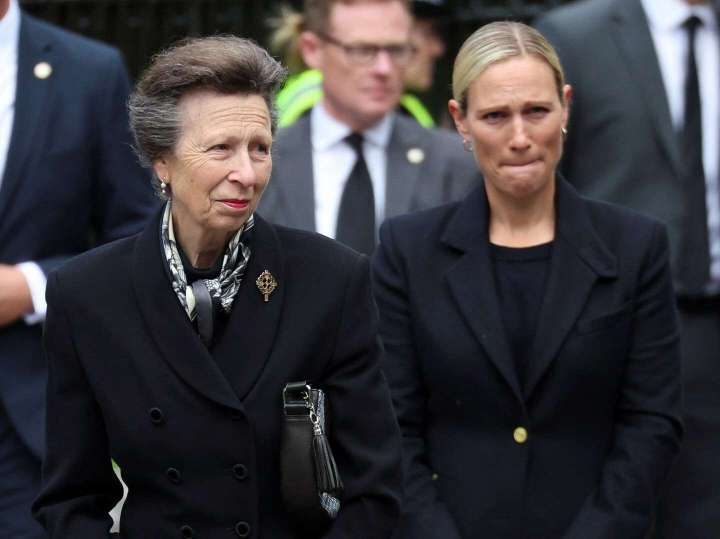You’re reading Post Elizabeth, Opinions’ newsletter following the British monarchy’s transition. Click here to get this newsletter in your inbox daily.
As royal family mourns, William and Harry make headlines in Windsor

The walkabout that made the front pages across the UK: Princes William and Harry and their wives greeted mourners outside Windsor Castle on Saturday, their first public outing as a foursome since Harry and his wife, Meghan Markle, opted out of royal duties and spoke critically of the palace and media treatment of Meghan. Some quickly speculated that the brothers may be repairing a rift. It’s too soon to know, and a forthcoming memoir by Harry could easily generate negative headlines. For now, it’s clear the royals are a family grieving. Two of the queen’s granddaughters were seen wiping away tears Saturday in Scotland as relatives viewed tributes outside the monarch’s residence there.
Before the appearance in Windsor, William issued a statement noting that much would be said about his grandmother’s reign but that his was also a personal loss: “She was by my side at my happiest moments. And she was by my side during the saddest days of my life. I knew this day would come, but it will be some time before the reality of life without Grannie will truly feel real.”
On Sunday, people lined streets in Scotland to watch the procession of the queen’s coffin as it was driven from her home at Balmoral Castle to the Palace of Holyroodhouse in Edinburgh. As the queen makes her final journey, many are thinking about her life. If you’re watching (or re-watching) “The Crown” on Netflix to get familiar with the queen, here’s a Post video that summarizes how the Netflix series humanizes Elizabeth.
Keep in mind: The show is not a documentary. Historian and royal biographer Robert Lacey is a consultant and has authored two companion books to the series. (The first book, with a chapter for each episode, has much more substance about the history of the periods depicted on the show and where the drama differs from reality.) Some inconsistencies are small: In the first episode, for example, then-Princess Elizabeth is shown in Malta with her husband, Prince Philip, and their two oldest children. In reality, the children were left behind in London while Elizabeth and Philip lived abroad. Later in the episode, the new queen is shown wondering why then-Prime Minister Winston Churchill wants to delay her coronation. In real life, there was no delay. If you find more faux “facts,” tweet at me (@Autumnsan1) and let me know what you’ve spotted.
Don’t miss
Coverage from around The Post
“Now, we wonder, ‘Who are we? And where are we going?’ ” With the end of the Elizabethan age, questions about the future loom, write Kevin Sullivan and Anthony Faiola. “Her passing comes as this island nation of 67 million was already mired in dire and complicated times, with the question of national identity — fraught and unanswered since the end of World War II — blurred and divisive.”
“Rest in peace, Queen Kong.” People have flocked to Buckingham Palace — “both a scene and a place to be seen” — since her death was announced Thursday, writes London correspondent Karla Adam. Among the flowers, pictures, Union Jack baseball caps and even Paddington Bears, “it’s the handwritten missives that stand out, ranging from the serious to the poignant, the rambling to the funny, many offering a window into how people felt about the queen.” (Note: Tributes are being moved into nearby Green Park every 12 hours to reduce buildup at palace gates.)
Let’s speak honestly about Britain’s “powerful and historically brutal empire,” says Post Opinion writer Karen Attiah. “In the global north’s imagination, the queen is a symbol of decorum and stability in the post-World War II world. But to people of places that Britain invaded, carved up and colonized over centuries,” views are radically different. “In the wake of the queen’s death, propaganda, fantasy and ignorance are being pitted against Britain’s historical record and the lived experience of Africans, Asians, Middle Easterners, the Irish and others.”
Remember the controversy about Harry and Meghan’s children not having titles? Now they’re entitled to them. Here’s an explainer from London reporter Annabelle Timsit.
Yes, souvenirs commemorating the queen are selling fast. But their value hasn’t spiked — yet, reports Jaclyn Peiser.
A share from Getty Images royal photographer @chrisjacksongetty
Follow @washingtonpost and @postopinions on Instagram for more news coverage.
Have questions about Britain’s royal transition? Submit them here.






